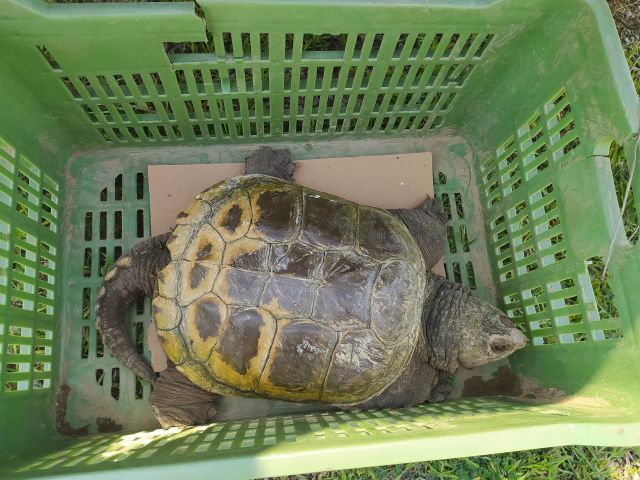The alligator snapping turtle or snapping turtle also gets its name from its knife-sharp, beak-like jaws, which it can use to shred its prey effortlessly.
An alligator snapping turtle was found along highway 7, next to a plastic compartment, the Balaton Upland National Park announced. The animal was presumably dumped in this crate, but it easily chewed it open and escaped.

Alligator turtle
Source: Facebook/Balaton Upland National Park
The police requested the help of the nature conservation guard service of the Balaton Upland National Park Directorate.
Due to the size of the animal, this was not easy either, because such a large specimen can already have a serious bite.
The alligator snapping turtle or snapping turtle (Chelydra serpentina) also got its name from the fact that it has knife-sharp, beak-like jaws with which it can effortlessly shred its prey. In addition, the species can be easily recognized by the horn cones on their tails, and in the case of young adults, smaller spines can be seen along the spine and rib shields. The strong claws on its legs also play a role in shredding prey.
The alligator snapping turtle is considered a particularly dangerous animal species and can only be legally kept in zoos.
The national park also drew attention to the fact that alligator snapping turtles are not only dangerous to humans. Since they have no natural enemies in our country, the individuals that get into nature can cause serious damage to the natural fauna. In addition, similar to the loggerhead turtle (Trachemys scripta), they also pose a threat to the bog turtle (Emys orbicularis), native to Hungary, which may eventually be completely displaced from their natural habitat. These species, which reach a larger body size and have a more aggressive behavior, represent significant competition for food for the bog turtle, and they can also displace our native turtle from their sunbathing and egg-laying places.
It is true for all the alligator snapping turtles that can be found in nature that they were originally brought into the wild by residents illegally as pets.
The turtle, which can initially be kept in a terrarium, can grow to a significant size (the body length of the specimen found now reaches 70 cm) and poses an increasing threat to its owners, therefore becoming a less and less welcome member of the family. This is when irresponsible farmers decide to release their former pet into the wild.
In addition to such cases, it has already been observed that the alligator snapping turtle captured by the nature conservation service laid dozens of eggs in the days following its capture, so it was suspected that the specimens released into the wild may sometimes be able to reproduce.
If we find a free-ranging alligator snapping turtle, the best course of action is to notify the National Park Directorate where it was found, whose territorially competent nature conservation officer will professionally capture the individual.
Until this happens, it is not worth experimenting with capture without suitable tools, because thanks to its surprising flexibility, it can easily cause injury by biting the animal. The captured turtles are given a chip and after that, after official approval, they are placed in zoos and turtle parks, the national park wrote.












